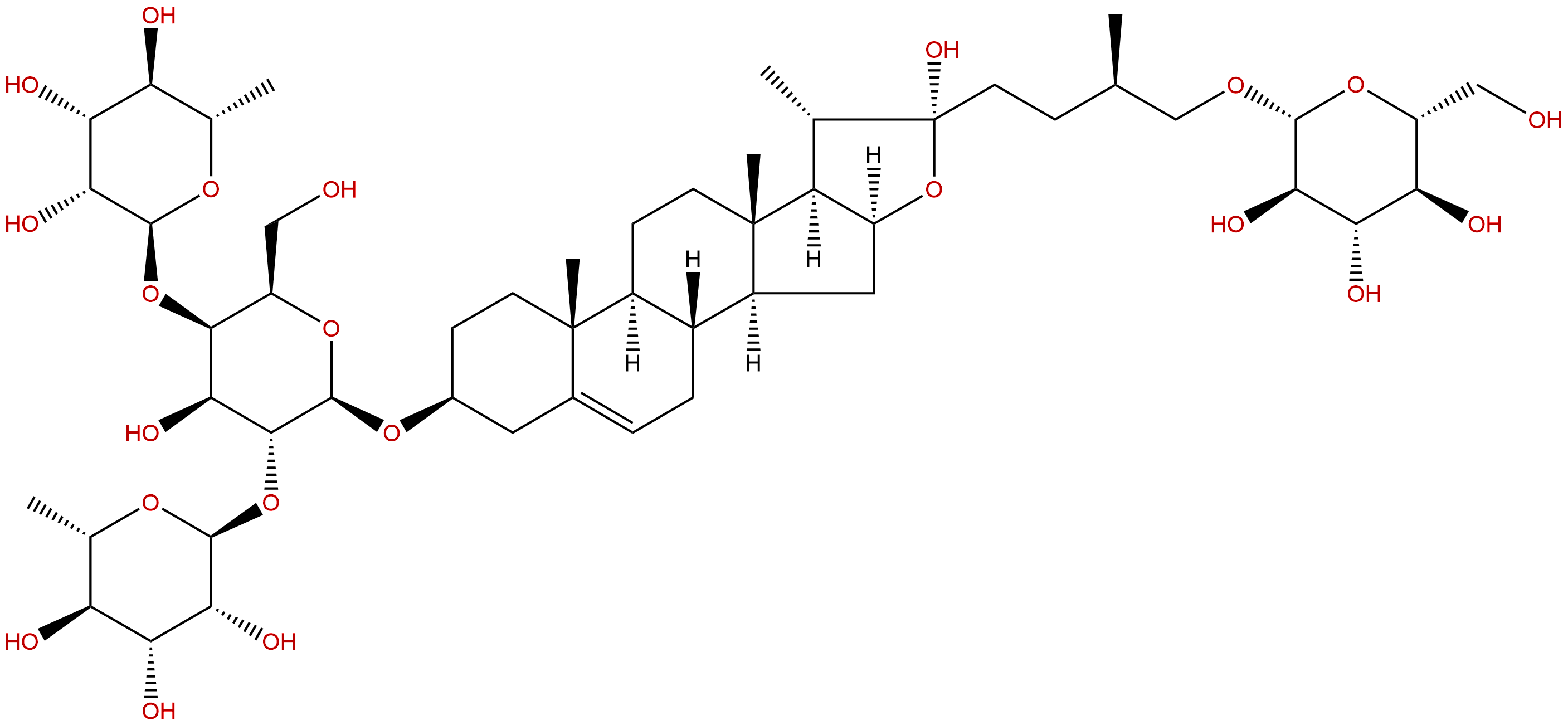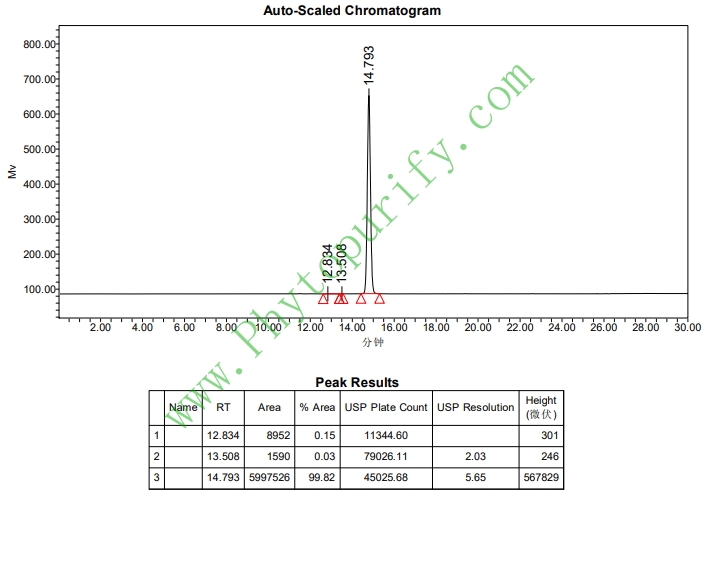
ProtodioscinCAS No.:55056-80-9
|
||||||||||
 |
|
|
||||||||

| Catalogue No.: | BP1156 |
| Formula: | C51H84O22 |
| Mol Weight: | 1049.21 |
Product name: Protodioscin
Synonym name: Saponin C
Catalogue No.: BP1156
Cas No.: 55056-80-9
Formula: C51H84O22
Mol Weight: 1049.21
Botanical Source: Dioscoreae Nipponicae Rhizoma
Physical Description:
Type of Compound: Steroids
Purity: 95%~99%
Analysis Method: HPLC-DAD or/and HPLC-ELSD
Identification Method: Mass, NMR
Packing: Brown vial or HDPE plastic bottle
Storage: Store in a well closed container, protected from air and light. Put into refrigerate or freeze for long term storage.
Whenever possible, you should prepare and use solutions on the same day. However, if you need to make up stock solutions in advance, we recommend that you store the solution as aliquots in tightly sealed vials at -20℃. Generally, these will be useable for up to two weeks.
The product could be supplied from milligrams to grams
Inquire for bulk scale.
Description:
Protodioscin has been shown to exhibit multiple biological actions, such as anti-hyperlipidemia, anti-cancer, sexual effects and cardiovascular properties. It appears to possess aphrodisiac activity probably due to its androgen increasing property, it will be useful in developing health food supplement(s) and/or drug(s) against hyperlipidemia.
References:
Antihyperlipidemic effect of protodioscin, an active ingredient isolated from the rhizomes of Dioscorea nipponica.
Developing drugs against metabolic-related disorders, including obesity and hyperlipidemia, is of importance for human health. Here, a bioactive phytochemical, Protodioscin, isolated from the rhizomes of Dioscorea nipponica (Rhizoma Dioscoreae Nipponicae), was identified for its anti-hyperlipidemic effect. In hyperlipidemic rats, the post-administration of Protodioscin significantly reduced the time of blood coagulation. In addition, the blood levels of triglyceride, cholesterol, low-density and high-density lipoproteins were also changed accordingly. Taken together, this was the first report of an antihyperlipidemic effect of Protodioscin. Its great availability in various vegetables and medicinal plants will be useful in developing health food supplement(s) and/or drug(s) against hyperlipidemia.
Protodioscin (NSC-698 796): its spectrum of cytotoxicity against sixty human cancer cell lines in an anticancer drug screen panel.
Protodioscin (NSC-698 796) is a furostanol saponin isolated from the rhizome of Dioscorea collettii var. hypoglauca (Dioscoreaceae), a Chinese herbal remedy for the treatment of cervical carcinoma, carcinoma of urinary bladder and renal tumor for centuries. To systematically evaluate its potential anticancer activity, Protodioscin was tested for cytotoxicity in vitro against 60 human cancer cell lines in the NCI's (National Cancer Institute, USA) anticancer drug screen. As a result, Protodioscin was cytotoxic against most cell lines from leukemia and solid tumors in the NCI's human cancer panel, especially selectively against one leukemia line (MOLT-4), one NSCLC line (A549/ATCC), two colon cancer lines (HCT-116 and SW-620), one CNS cancer line (SNB-75), one melanoma line (LOX IMVI), and one renal cancer line (786 - 0) with GI50 < or = 2.0 microM. In the general view of mean graphs, leukemia, colon cancer and prostate cancer are the most sensitive subpanels, while ovarian cancer is the least sensitive subpanel. Based on an analysis of COMPARE computer program with Protodioscin as a seed compound, no compounds in the NCI's anticancer drug screen database have cytotoxicity patterns (mean graphs) similar to those of Protodioscin, indicating that a potential novel mechanism of anticancer action is involved.
Quantification of protodioscin and rutin in asparagus shoots by LC/MS and HPLC methods.
A liquid chromatography/mass spectrometry (LC/MS) method with selected ion monitoring was developed and validated to analyze the contents of Protodioscin and rutin in asparagus. The distribution of rutin and Protodioscin within the shoots was found to vary by location, with the tissue closest to the rhizome found to be a rich source of Protodioscin, at an average level of 0.025% tissue fresh weight in the three tested lines, while the upper youngest shoot tissue contained the highest amount of rutin at levels of 0.03-0.06% tissue fresh weight. The lower portions of the asparagus shoots that are discarded during grading and processing should instead be considered a promising source of a new value-added nutraceutical product.
A comparative tissue-specific metabolite analysis and determination of protodioscin content in Asparagus species used in traditional Chinese medicine and Ayurveda by use of laser microdissection, UHPLC-QTOF/MS and LC-MS/MS.
To compare tissue-specific metabolites and Protodioscin content of Asparagus cochinchinensis (Lour.) Merr. and Asparagus racemosus Willd. used in China and India. METHODS: Metabolite analysis of laser-dissected tissues was carried out using UHPLC-QTOF/MS and LC-MS/MS. The Protodioscin contents were determined and the method was validated as per the International Conference on Harmonisation of Technical Requirements for Registration of Pharmaceuticals for Human Use guidelines. Although the metabolite profiles were similar, the content of Protodioscin was found to be higher in Chinese than Indian species. CONCLUSION: The study provided a suitable methodology for metabolite profiling and Protodioscin content determination of Asparagus by use of LMD, UHPLC-QTOF/MS and LC-MS/MS. The similarities in metabolite profiles indicate that Asparagus species from India and China can serve as substitute for each other in various therapeutic and pharmaceutical applications.
Aphrodisiac properties of Tribulus Terrestris extract (Protodioscin) in normal and castrated rats.
Tribulus terrestris (TT) has long been used in the traditional Chinese and Indian systems of medicine for the treatment of various ailments and is popularly claimed to improve sexual functions in man. Sexual behaviour and intracavernous pressure (ICP) were studied in both normal and castrated rats to further understand the role of TT containing Protodioscin (PTN) as an aphrodisiac. Adult Sprague-Dawley rats were divided into five groups of 8 each that included distilled water treated (normal and castrated), testosterone treated (normal and castrated, 10 mg/kg body weight, subcutaneously, bi-weekly) and TT treated (castrated, 5 mg/kg body weight, orally once daily). Decreases in body weight, prostate weight and ICP were observed among the castrated groups of rats compared to the intact group. There was an overall reduction in the sexual behaviour parameters in the castrated groups of rats as reflected by decrease in mount and intromission frequencies (MF and IF) and increase in mount, intromission, ejaculation latencies (ML, IL, EL) as well as post-ejaculatory interval (PEI). Compared to the castrated control, treatment of castrated rats (with either testosterone or TT extract) showed increase in prostate weight and ICP that were statistically significant. There was also a mild to moderate improvement of the sexual behaviour parameters as evidenced by increase in MF and IF; decrease in ML, IL and PEI. These results were statistically significant. It is concluded that TT extract appears to possess aphrodisiac activity probably due to androgen increasing property of TT (observed in our earlier study on primates).
HPLC of Protodioscin
